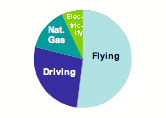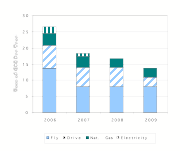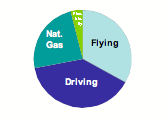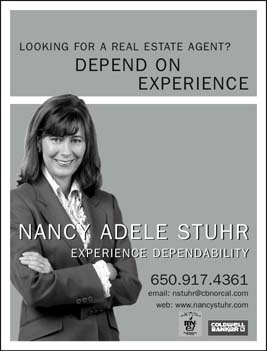|
|
| Home |
| About OMVNA |
| Emergency Preparedness |
| Newsletter |
| OMVNAtalk E-mail list |
| Coming Events |
| Meeting Minutes |
| Steering Committee |
| Heritage Homes |
| Links |
| Advertisers |
OMVNA Newsletter
July 2007
Volume 19, Number 5
The OMVNA Newsletter is distributed to 1900 households and 175 downtown businesses by dedicated volunteers. The opinions expressed are not necessarily those of the OMVNA Steering Committee. Let us know what you think!
Editor: Bruce Karney
Phone: (6 - 9 PM only) 964-3567
E-mail: editor@omvna.org
Mail: 833 Bush St., Mountain View 94041
IN THIS ISSUE:
OMVNA Ice Cream Social
City Commissions, Boards & Committees Want YOU!
Summertime is Exercise Time
Castro Street Closure is a Hit with Most Residents
You Could be the 300th OMVNAtalk Subscriber
The Critter Column: Alligator Lizards
Join the Steering Committee
Energy Action: What’s a Carbon Footprint?
Steering Commmittee Meets
Steering Committee News
Our Newsletter Sponsors
JUMP CASTLES! FREE ICE CREAM!
August 19th, 2:00-4:00 p.m.
Featuring:
Twee-Twee the Clown
Elvis Presley (or someone like him)
Mercy-Bush Park
City Commissions, Boards & Committees Want YOU!
Are you ready to help make Mountain View a better place to live? Then why not apply to serve on one of the many City Boards, Commissions or Committees?
These groups all provide advice in their areas of expertise to the City Council. Service on a Committee is a great way to make a contribution to the community.
It’s a good idea to attend one or two meetings of the Board that you’re interested in before applying. You’d be surprised how many applicants don’t do this. Such applicants are rarely selected to serve.
Except as noted, all meetings begin at 6:30, 7:00 or 7:30 p.m.
- Bicycle/Pedestrian Advisory Committee: last Wednesday of the month
- Development Review Committee (members must be architects): Thursday afternoons
- Downtown Committee: first Tuesday of every other month at 8 a.m.
- Environmental Planning Commission: first and third Wednesdays
- Human Relations Commission: first Thursday
- Library Board: third Monday
- Moffett Field Restoration Advisory Board: meets as needed
- Parks and Recreation Commission: second Wednesday
- Performing Arts Committee: third Wednesday
- Visual Arts Committee: second Wednesday at 6:00 p.m.
- Youth Advisory Group (members must be entering the 7th through 12th grades): first Monday 4:30 p.m.
Call the City Clerk's office at 903-6304 for further info and application forms. You can find the form online at tinyurl.com/2aslhc.
Summertime is Exercise Time
By Chris Peters
 Some physical activity is desirable every day of the year, every day of our life. Our friend, the body, functions best when energized by movement. Generally speaking, summer is a time for heightened activity. More sunshine and warmer temperatures call us to move just as other animals and plants burst with vital movement during the summer. When we are in sync with the rhythms of nature we enjoy nature’s support of our well being.
Some physical activity is desirable every day of the year, every day of our life. Our friend, the body, functions best when energized by movement. Generally speaking, summer is a time for heightened activity. More sunshine and warmer temperatures call us to move just as other animals and plants burst with vital movement during the summer. When we are in sync with the rhythms of nature we enjoy nature’s support of our well being.
The warmth of summer supports us in opening up, lengthening and stretching. A walk around the neighborhood may be a good place to start. Our neighborhood is wonderful for early morning exercise. Especially in summer (school out, people on vacation) the streets are quiet, except for the symphony of nature! Like a great conductor, the morning summer sun coaxes local song birds to strike a heavenly chord.
When I want more of a plunge into movement I enjoy the new track at Graham School. It’s a peaceful place to walk, jog, or run. I also appreciate the Stevens Creek Trail and Shoreline Park as great places for walking, running and cycling. Eagle Park (grass), Cuesta Park (asphalt trails) and Rancho San Antonio (nature trails) are other favorite areas I choose to “spread my wings.”
However you choose to do it – by walking, running, swimming, cycling, doing sit-ups or Tai Chi – I invite you to practice saying “yes” to summer activity.
Castro Street Closure is a Hit with Most Residents
By Bruce Karney, Editor
A spirited debate erupted on OMVNAtalk in late June when plans were first announced to close the northern end of Castro Street on four Thursday evenings this summer. Following an initial posting by Aaron Grossman on June 24, thirty comments were added in the next few days.
Future closures will occur on Aug. 2, Aug. 16 and Sept. 13. Castro will be closed to motor vehicles from Evelyn to Church from approximately 5 to 11 p.m. (but you can still drive across Castro on Church and get on Moffett from Evelyn). Walkers, bikers and strollers are welcome – the idea is to close the street to cars but open it to pedestrians.
I invited neighbors to share their thoughts following the first closure on July 12. I received more than 30 e-mails! The remainder of this article presents a representative sampling of the comments I received.
Natasha Keck wrote: “I attended the first Thursday Night Live with my husband and our two young children. It was great! My kids had a blast with the activities and we enjoyed eating dinner on the curb while greeting friends and neighbors. The kids sure thought it was swell to be able to run around in the middle of the street, make chalk drawings, and generally claim Castro street as theirs if only for a couple hours. We'll definitely be attending future Thursday Night Live events.”
Church Street resident and professional comedian Karen Smyth wrote: “Walking down Castro we stopped at a few booths and then on to Zucca for dinner. We all appreciated the neighborhood energy of the event and the mini-Farmers Market. It felt much more that it was something unique to Mountain View than any of the art and wine festivals... I have already marked my calendar for next month.”
Margaret Hutz suggested: “I hope there will be more Farmers Market booths in future. It's very convenient to have the opportunity to replenish supplies of fresh Farmers Market produce mid-week.”
Brigitte Fleeman from Front Street wrote: “The atmosphere was a little bit like in Germany where many smaller towns have made a big success with pedestrian zones... Burlington, Vermont has had a pedestrian zone for years with great success.”
Dalma Drive resident Boris Burtin wrote: “I thought it was great! The nice thing about the street closure was that it had a small town feeling to it. Our kids had a great time playing with the chalk, bubbles and toys, listening to the music and looking at the fish and turtles at the pet store.”
Dana resident Rita Pilkenton wrote: “I want to cast my vote for Thursday Night Live... My family of four walked downtown and had a fun time! What a joy to walk downtown and not have to deal with cars. We saw lots of neighbors and enjoyed outside dining and browsing. My husband, who commutes from Milpitas, had forgotten the street closure, but the detour was less than five minutes and definitely worth it.”
Lauren Zuravleff, who lives on Mercy near Landels, wrote: “I had a great time and plan to walk downtown to all of these events. I met friends for dinner who live on the other side of Shoreline who also walked downtown. I ran into many neighbors and also friends from other parts of our city. It seemed much more intimate than the larger Art & Wine Festival. It was so nice to sit outside without the traffic.”
Noise Not an Issue
Jeff Segall wrote: “As far as noise is concerned … during the periods when I was home, it was a complete non-issue. At California near Hope, I live closer to downtown than just about anyone in the neighborhood.”
Anza resident Jack Perkins reported: “I think it was good. We were not plagued with loud music from four blocks away. My wife went down and came back positive. Loud music is our irritant and this was not irritating.”
Traffic Concerns
Downtown architect Randy Potter of Vox Design Group called the event a raging success and wrote: “I drove out from behind Castro Street twice during the street closing and never experienced more than 2 or 3 cars at stop signs trying to get around the closures; it seems the traffic nightmares never materialized.”
Kim Bandelier wrote that the “street closure significantly increased traffic on streets close to Castro. Specifically at Franklin and California (where there is no stop sign for California traffic, often resulting in near accidents), parking for residents was compromised and traffic congestion made accessing or leaving our home impossible. I hope the street closure will not become a regular occurrence.”
We solicited comments from employees of Fenwick and West, the law firm in the 400 block of Castro, and got several replies.
Ken Arendt wrote: “The one glaring problem is the rerouted traffic onto Bryant. Turning left from Bryant onto California Street at 6 p.m. was not possible due to cars clogging the intersection. This could be resolved with changing the light to a three-way signal.
Tahir Naim wrote: “I used to live on Loreto. I now live in Sunnyvale. I did see a great deal of traffic backed up on Bryant apparently trying to negotiate their way to El Camino from Moffett. I think a lot of people were thrown off by this closure and I would not be surprised if the restaurants on Castro suffered a drop in business. Honestly, I don't see the point of this inconvenience. It was much nicer to just have a little music on the steps of the MVCPA.”
Ramona DeJesus-Riviera’s succinct comment was: “It was a bit confusing getting out of the closed areas and back on track to go home.”
You Could be the 300th OMVNAtalk Subscriber
OMVNAtalk is our Yahoo!Group for sharing neighborhood news. It began on Feb. 24, 2000 and now has 297 subscribers. During the last seven years there have been 1,969 postings on a huge variety of topics.
You should join OMVNAtalk if you would like to send and receive e-mail about issues of interest to other Old Mountain View residents. OMVNAtalk is a moderated list, which prevents spam and off-topic posts.
You may send requests and announcements of any kind, including commercial announcements, as long as there is a clear link to Old Mountain View.
To join OMVNAtalk, visit: www.omvna.org/omvnatalk.html
The Critter Column: Alligator Lizards
By Jack Perkins
 Our neighborhood is home to the alligator lizard -- a large, feisty reptile that is capable of inflicting a painful bite. Though it prefers to run and hide, it will bite if you grab it, so if you are feeling adventurous, use garden gloves. The alligator lizard, or Elgaria multicarinata, gets its name because it looks like a miniature alligator when it opens its mouth wide in a threat display.
Our neighborhood is home to the alligator lizard -- a large, feisty reptile that is capable of inflicting a painful bite. Though it prefers to run and hide, it will bite if you grab it, so if you are feeling adventurous, use garden gloves. The alligator lizard, or Elgaria multicarinata, gets its name because it looks like a miniature alligator when it opens its mouth wide in a threat display.
Don’t grab it by the tail because it is designed to lose its tail in order to escape from predators, leaving behind a twitching detached tail -- a decoy that gives the lizard a few precious seconds to escape.
Full grown lizards that have never lost their tails can grow to 21 inches from end to end. The body is seven inches and the tail 14 inches. However, most alligator lizards have lost their tails in encounters with predators. The tail does regenerate, but grows back shorter and a different color. The one in my back yard is a foot long and its tail is stubby – a reminder of a previous close call.
If your yard is home to an alligator lizard, look for it in a wood pile, rock pile, thick stands of plants, or the part of the yard that never gets any attention and where debris piles up.
We have one living in a large thick patch of flowers. It gives my wife the willies when it jumps out to make its escape. It runs fast on short legs, dragging its belly on the ground, very snake-like. It sure makes yard work exciting!
Alligator lizards have prehensile tails. By using the tail as a support, or to hang onto branches, they can maneuver through vegetation quite effectively.
Their diet includes various insects, young mice and birds, tree frogs, and even other lizards. Mating season is in May and as many as twenty eggs are laid in June or July. The incubation period is about fifty-five days, after which the babies are born live. They are rarely more than three inches long from nose to tail.
I like having them around, and hope you will treat them gently if you find them in your yard.
Join the Steering CommitteeOMVNA is a volunteer organization whose purpose is to preserve and improve the quality of life in our neighborhood. The Association is nearly twenty years old, and it adopted by-laws and elected its first Steering Committee in 1992. Since then more than forty individuals have served on the Steering Committee. Their energy, dedication, and creativity have allowed OMVNA to provide a wide range of services and benefits to residents and downtown businesses, including this newsletter and our OMVNAtalk Yahoo!Group to improve communication; our Council Candidate Forums; the fun of picnics, potlucks and other gatherings; disaster planning and first responder training provided by the Community Emergency Response Team (CERT), and advocacy for the neighborhood’s interests with city staff and City Council members.
OMVNA and its members have many accomplishments to be proud of, including traffic calming measures that have reduced speeding and traffic volumes on many residential streets and the creation and design of Mercy-Bush Park.
Each summer we begin the process of seeking new volunteers for our Steering Committee. Whether you’ve lived here a few months or a few decades, if you appreciate the unique nature of our neighborhood and would like to volunteer your time and talents to preserve and improve it, we would love to hear from you.
Please come to one of our Steering Committee meetings to meet the current members and get a feel for what we do.
Energy Action Column: What’s a Carbon Footprint?
By Bruce Karney
The Energy Action column provides information on ways that we can reduce the amount of energy and fossil fuel we consume, thereby saving money and helping the environment.
You may have heard the term “carbon footprint” lately and been puzzled about what it means.
Carbon footprint is a measure of the amount of carbon dioxide (CO2) that a person or family produces each year as the result of burning fossil fuels or consuming goods and services produced using fossil fuels. Because CO2 is gradually accumulating in the atmosphere, our planet is warming. Reducing your carbon footprint is one of the most important ways that individuals and families can fight global warming.
Most of us are environmentally conscious enough that we wouldn’t think of throwing a gum wrapper on the sidewalk, yet we create more than half a ton of global warming pollution each month with nary a thought. Because Americans produce more CO2 pollution per capita than almost any other nation, if enough of us take action to shrink our carbon footprints we can slow the pace of global warming.
The three most common fossil fuels are oil, natural gas and coal, all of which were created millions of years ago from decayed organic matter; hence the use of the term “fossil” to describe them.
The Four Components
You can calculate your carbon footprint by examining four areas of energy consumption:
- Driving
- Flying
- Home natural gas use
- Home electricity use
We produce carbon dioxide pollution in other ways (such as in our workplaces or in the production of products we buy), but measuring these effects is well beyond the scope of this article.
Our Footprint and Action Plan
When my wife and I first calculated our carbon footprint last year, we were shocked to see that flying accounted for more than half of our CO2 production. The pie chart below shows how much each of the four activities contributed to the 26 tons of CO2 we produced last year.


2006 – 26 tons
We didn’t think of ourselves as frequent fliers – in fact, we only got on planes ten times in 2006 – but we did travel to China together, and that one trip accounted for 26,000 air miles – far more miles than we drove during the year. Airplanes get about 20 passenger-miles/gallon, so our trip to China released as much pollution as if we’d driven a large car around the equator.
After seeing how much pollution we’d generated, we made a plan to cut our carbon emissions by at least half over the next three years. (See bar chart). 
Energy ActionPart of that plan was to reduce the number of miles we fly, and another part was to “go solar.” Even though we’ve only had our solar photovoltaic system running for two months, our carbon footprint for the first half of 2007 already looks different from last year’s.


2007 – 18 tons (projected)
As we’ve cut back on flying, the impact of our driving habits has become the dominant concern. My wife has been driving a hybrid for a little over a year, but I’m still driving a large sedan. Clearly, a smaller and more fuel efficient car is the next step we’ll be taking this year or next.
There are many web sites that let you calculate your carbon footprint. I recommend Cool It! at: cool-it.us/index.php?refer=Acterra You can calculate your footprint and also offset it using carbon offsets, which will be the subject of next month’s column.
Future meetings: August 13, and September 10 at 7:30 p.m. 580 Castro St. in the Chamber of Commerce Board Room. Everyone is welcome to attend!
May
The Committee voted to budget $2,600 for the summer picnic and began planning it. It also unanimously approved a donation of $100 to Save the Bay to support its work in protecting and restoring San Francisco Bay.
Webmistress Shelly King presented a proposal to replace the current OMVNA web site with a new design based on blogging software instead of continuing to use Dreamweaver. She said that key benefits include easier updating, the ability of multiple people to manage it, and the possibility of interaction through the blogging software’s “commenting” feature. Chairman Ken Rosen-berg requested that Shelly advance to the next stage of prototyping her ideas and bring them to a future Committee meeting.
June
Planning continued for the OMVNA Ice Cream Social on August 19. The Committee heard an update from City staffer Peter Skinner on the upcoming “Thursday Night Live” closures of Castro Street from Evelyn to Church.
Treasurer Aaron Grossman reported that our finances are in great shape. We’ve already exceeded our revenue goal for 2007, and our expenses halfway through the year are slightly under budget.
In Memoriam: Mary Tutman, Anne Bakotich and Pete Chambliss
During the past two months I was saddened to learn of the passing of three wonderful members of our community. Members of the “greatest generation,” all three were bright, loving, generous -- and irreplaceable.
Mary Tutman, the widow of former City Council Member Jack Tutman, passed away in May at the age of 91.
Anne Bakotich, a lifelong resident of Old Mountain View and owner of the second oldest home in Mountain View, was 90 when she died on June 1.
Pete Chambliss, WWII veteran and father of five, passed away on June 10, his 89th birthday.
Their obituaries are online at www.mercurynews.com/obituariesAdvertise in the Newsletter!
Call 964-3567 for info or visit http://omvna.org/adrates.html




>





The OMVNA Newsletter
is published by a volunteer editorial committee & distributed to some 2200 homes and businesses by volunteers.
To get in touch with us:
- Write to P.O.Box 391328, Mtn. View, CA 94039
- E-mail the editor editor@omvna.org
- Find us on the Web at http://www.omvna.org
The opinions printed in this newsletter are not necessarily those of the OMVNA Steering Committee.

